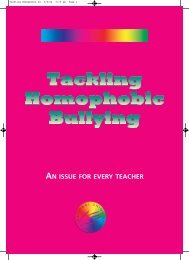Non-Normative Gender and Sexual Identities in Schools: - Schools Out
Non-Normative Gender and Sexual Identities in Schools: - Schools Out
Non-Normative Gender and Sexual Identities in Schools: - Schools Out
You also want an ePaper? Increase the reach of your titles
YUMPU automatically turns print PDFs into web optimized ePapers that Google loves.
GUIDANCE 07<br />
Executive summary<br />
boxes. Evaluate the responses received <strong>and</strong><br />
ensure consistent record<strong>in</strong>g <strong>and</strong> report<strong>in</strong>g.<br />
• Raise awareness of what homophobic bully<strong>in</strong>g<br />
is <strong>and</strong> how the school will respond. Ensure<br />
effective report<strong>in</strong>g systems are <strong>in</strong> place to enable<br />
pupils to report <strong>in</strong>cidents.<br />
• Evaluate <strong>and</strong> make use of curriculum<br />
opportunities <strong>in</strong> order to <strong>in</strong>stil respect for others.<br />
• Develop effective <strong>in</strong>tervention strategies.<br />
• Know how to provide sensitive support to<br />
lesbian <strong>and</strong> gay pupils to help them feel safe,<br />
<strong>and</strong> able to tell teachers about <strong>in</strong>cidents of<br />
homophobic bully<strong>in</strong>g.<br />
Summary<br />
16. To create an <strong>in</strong>clusive environment <strong>in</strong> your school<br />
where all pupils feel safe <strong>and</strong> are able to fulfil their<br />
potential requires a whole school approach. This should<br />
be <strong>in</strong>tegral to your school’s mission statement <strong>and</strong><br />
overall vision. The follow<strong>in</strong>g ten steps can be taken to<br />
address homophobic bully<strong>in</strong>g <strong>in</strong> your school:<br />
1. Acknowledge <strong>and</strong> identify the problem of<br />
bully<strong>in</strong>g. The most important step is to recognise<br />
that all sorts of bully<strong>in</strong>g takes place <strong>in</strong> schools, even<br />
if some forms are not immediately visible.<br />
2. Develop policies which recognise the existence<br />
of homophobic bully<strong>in</strong>g. Ensure that your antibully<strong>in</strong>g<br />
policy takes homophobic bully<strong>in</strong>g <strong>in</strong>to<br />
account. Take other appropriate action such as<br />
challeng<strong>in</strong>g use of the word ‘gay’ <strong>and</strong> ensur<strong>in</strong>g fast<br />
removal of graffiti.<br />
3. Promote a positive social environment. The<br />
ethos of the entire school community, <strong>in</strong>clud<strong>in</strong>g all<br />
staff <strong>and</strong> parents/carers, should be to support all<br />
pupils, regardless of their differences <strong>and</strong> to ensure<br />
that they are happy <strong>and</strong> safe.<br />
4. Address staff tra<strong>in</strong><strong>in</strong>g needs. Do not assume that<br />
only lesbian, gay <strong>and</strong> bisexual staff are able to deal<br />
with homophobic bully<strong>in</strong>g, but ensure all staff are<br />
confident they know how to react to such situations.<br />
5. Provide <strong>in</strong>formation <strong>and</strong> support for pupils.<br />
Make age-appropriate <strong>in</strong>formation about services<br />
<strong>and</strong> support available to all pupils. Refer pupils to<br />
services <strong>in</strong>clud<strong>in</strong>g ChildL<strong>in</strong>e for additional support.<br />
6. Include address<strong>in</strong>g bully<strong>in</strong>g, <strong>in</strong>clud<strong>in</strong>g<br />
homophobic bully<strong>in</strong>g, <strong>in</strong> curriculum plann<strong>in</strong>g.<br />
Try to <strong>in</strong>clude teach<strong>in</strong>g about bully<strong>in</strong>g, <strong>in</strong>clud<strong>in</strong>g<br />
homophobic bully<strong>in</strong>g, <strong>in</strong> the curriculum as a whole<br />
<strong>in</strong> an age-appropriate way <strong>and</strong> <strong>in</strong> accordance with<br />
National Curriculum subject frameworks <strong>and</strong><br />
guidance so that pupils underst<strong>and</strong> <strong>and</strong> appreciate<br />
diversity. This can be done formally <strong>in</strong> lesson times,<br />
but also <strong>in</strong>formally, e.g. by provid<strong>in</strong>g <strong>in</strong>formation<br />
about LGB groups with<strong>in</strong> secondary schools, <strong>in</strong><br />
accordance with the school’s policy.<br />
7. Feel able to use outside expertise. People<br />
work<strong>in</strong>g <strong>in</strong> external agencies (such as lesbian <strong>and</strong><br />
gay charities, youth workers or local telephone<br />
helpl<strong>in</strong>es) can offer support, both outside <strong>and</strong> <strong>in</strong>side<br />
the classroom, <strong>in</strong> address<strong>in</strong>g homophobic bully<strong>in</strong>g.<br />
8. Encourage role models. Openly gay staff,<br />
governors, parents/carers <strong>and</strong>/or pupils can all be<br />
strong role models for the school.<br />
9. Do not make assumptions. Do not assume that<br />
all pupils <strong>in</strong> a class are, or will be, heterosexual. Do<br />
not assume that all staff <strong>in</strong> a school or college are<br />
heterosexual. And do not assume that all pupils<br />
experienc<strong>in</strong>g homophobic bully<strong>in</strong>g are gay.<br />
10. Celebrate achievements. Make successes known,<br />
such as updat<strong>in</strong>g the school anti-bully<strong>in</strong>g policy or<br />
reduc<strong>in</strong>g the <strong>in</strong>cidence of bully<strong>in</strong>g, through tutorial<br />
time, newsletters, notice-boards or websites etc.







